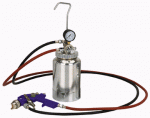jesusgatos
Active member
- 2,689
- 28
- 38
- Location
- on the road - in CA right now
OK. I need some help. Just bought one of these HVLP paint guns from Harbor Freight (part number 93305 if the link doesn't work). I've never used a paint gun before, and I'm not finding the instructions very helpful (typical HF). The instructions are actually so bad that they tell you to hook-up the paint/air lines backwards in one diagram. Fortunately I figured that out before I actually tried to paint anything...
I bought a glad-hand hook-up to the service-air line, and I've connected a cheap desiccant air filter from HF to that. Then I put a mini-regulator inline behind that, and connected my air hose to that. The instructions say to regulate the incoming air to 30-43psi. No problem.
Then they say to set the regulator on the pressure-cup to 10-30psi. But I've tried adjusting the regulator from all the way open to all the way closed, and it doesn't seem to have any effect on the air pressure at all.
I've managed to regulate the pressure by bleeding-off the majority of the excess air pressure through the safety valve, but I'd still like to figure out what's wrong with the regulator on the pressure-cup.
I've painted some cardboard boxes and small parts, and I'm thinking this might actually work alright (assuming I can figure out how the regulator is supposed to work). I know this is a little bit ghetto, but am I crazy to think that I might be able to use the air compressor on the deuce to paint the deuce?
Next question: I'm going to relocate my air tanks and run new air lines soon. When I do that, I was thinking that maybe it would be a good idea to plumb a nice air filter/dryer into the system. Should I look at components that would be used in a shop, or would I be better of using one of those air dryers like the big rigs put in trucks? If I use shop components, I'm guessing that I'd need to run them on an accessory line that I can turn on/off (in order to keep from losing air pressure to the brakes if any of those components failed). I think I've seen some pictures of a few trucks that people have installed these type of air filters/dryers on, but I can't find any of them now.
I bought a glad-hand hook-up to the service-air line, and I've connected a cheap desiccant air filter from HF to that. Then I put a mini-regulator inline behind that, and connected my air hose to that. The instructions say to regulate the incoming air to 30-43psi. No problem.
Then they say to set the regulator on the pressure-cup to 10-30psi. But I've tried adjusting the regulator from all the way open to all the way closed, and it doesn't seem to have any effect on the air pressure at all.
I've managed to regulate the pressure by bleeding-off the majority of the excess air pressure through the safety valve, but I'd still like to figure out what's wrong with the regulator on the pressure-cup.
I've painted some cardboard boxes and small parts, and I'm thinking this might actually work alright (assuming I can figure out how the regulator is supposed to work). I know this is a little bit ghetto, but am I crazy to think that I might be able to use the air compressor on the deuce to paint the deuce?
Next question: I'm going to relocate my air tanks and run new air lines soon. When I do that, I was thinking that maybe it would be a good idea to plumb a nice air filter/dryer into the system. Should I look at components that would be used in a shop, or would I be better of using one of those air dryers like the big rigs put in trucks? If I use shop components, I'm guessing that I'd need to run them on an accessory line that I can turn on/off (in order to keep from losing air pressure to the brakes if any of those components failed). I think I've seen some pictures of a few trucks that people have installed these type of air filters/dryers on, but I can't find any of them now.
Attachments
-
22.7 KB Views: 5



